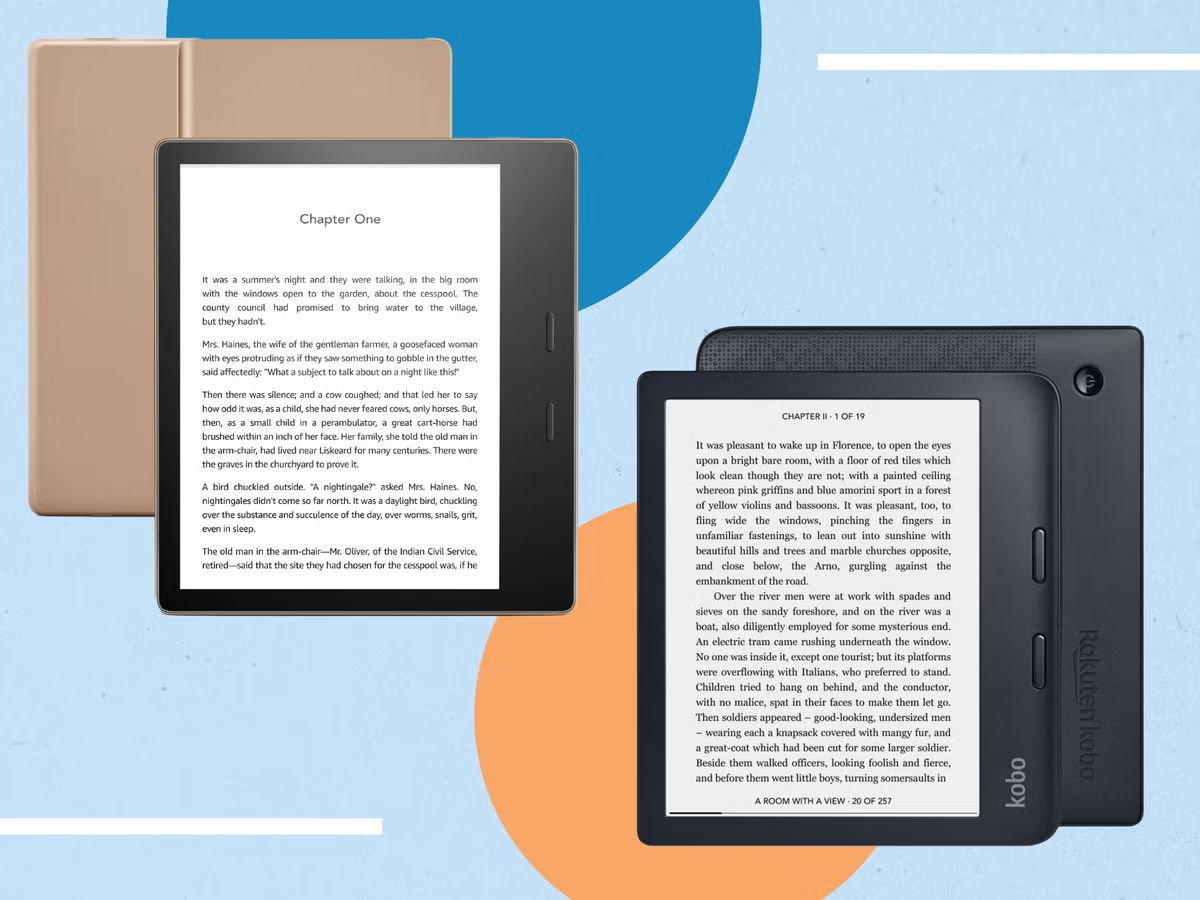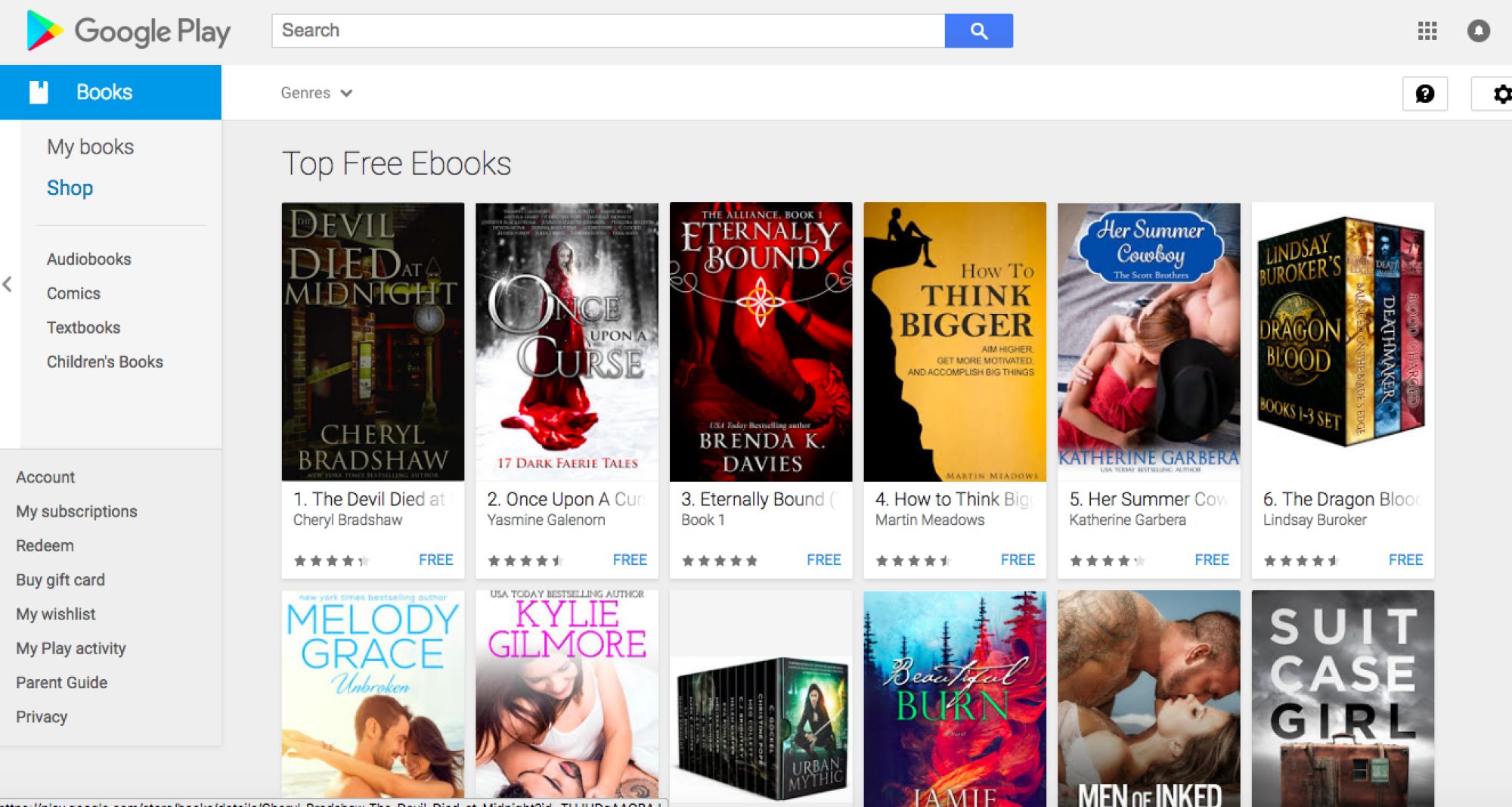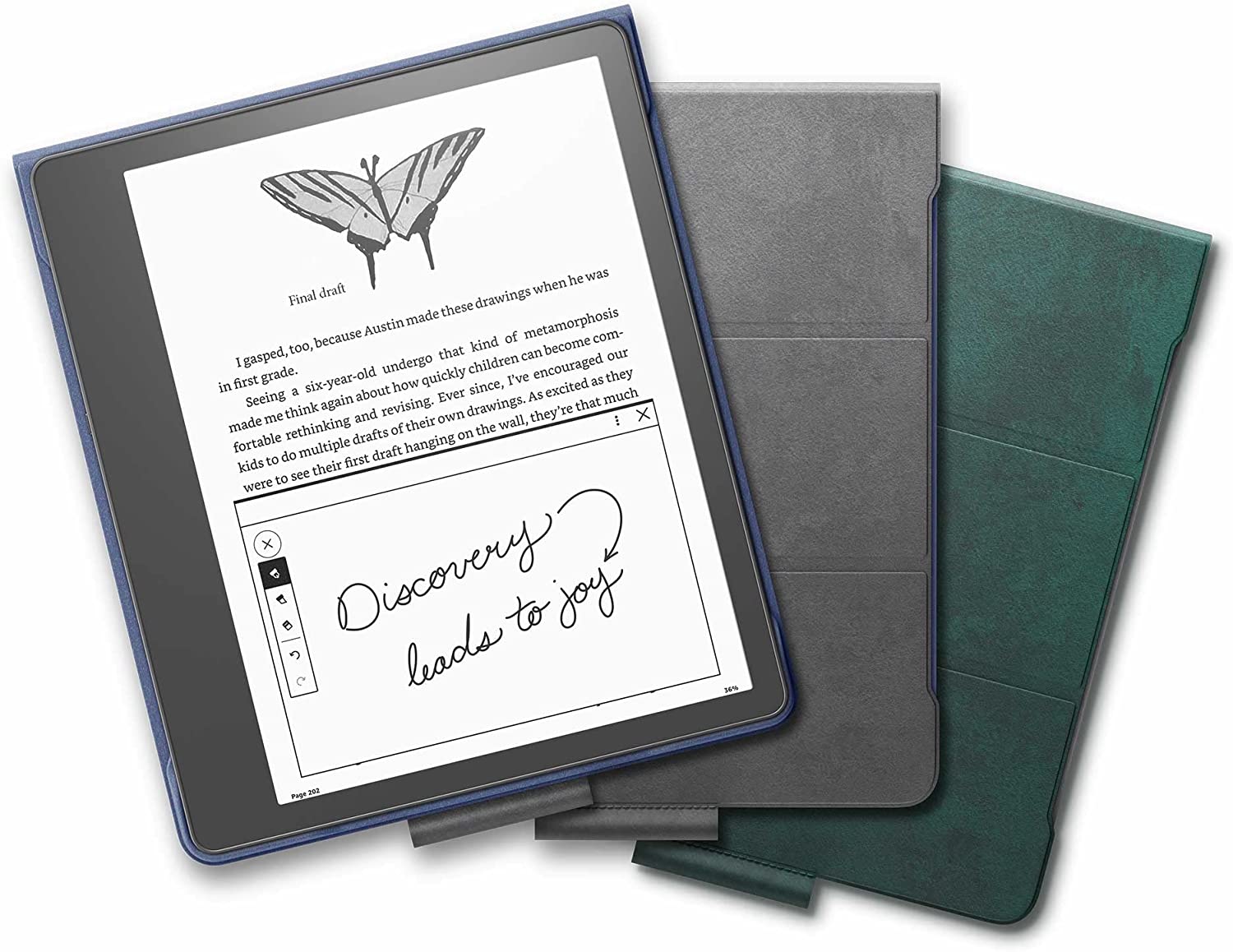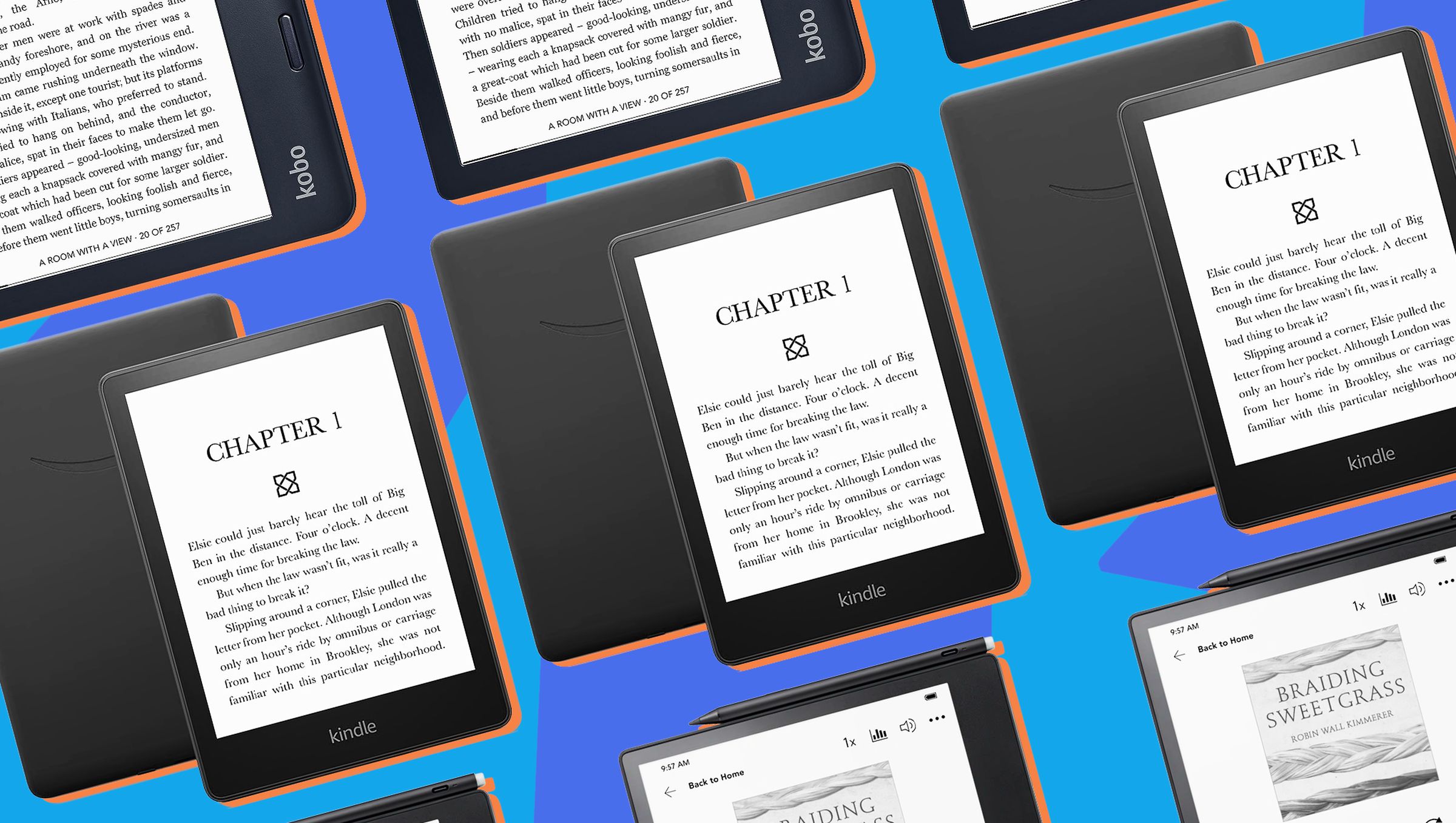Introduction
An eBook, short for electronic book, is a digital publication that can be read on electronic devices such as e-readers, tablets, and smartphones. Over the past decade, the popularity of eBooks has soared, revolutionizing the way we read and consume information.
With the advancement of technology, eBooks have become increasingly accessible and convenient. They offer numerous benefits over traditional printed books, including portability, flexibility, and affordability. In this article, we will explore what an eBook looks like, its formats, and the key elements that make up its layout.
Before delving into the specifics, it’s important to note that an eBook can take different shapes and forms depending on the device and platform it is viewed on. However, the fundamental structure and components remain consistent across most eBook formats.
Whether you’re considering publishing your own eBook or simply curious about the inner workings of this digital medium, understanding the principles of eBook layout is essential. From cover design to typography and page layout, every aspect plays a crucial role in creating a visually appealing and user-friendly reading experience.
In the following sections, we will delve into the various components that comprise an eBook layout. We’ll explore cover design, title pages, table of contents, chapter formatting, typography, images, page layout, and much more. By the end, you’ll have a comprehensive understanding of what goes into creating a beautiful and engaging eBook.
What is an eBook?
An eBook is a digital version of a book that can be read on electronic devices such as e-readers, tablets, or smartphones. Unlike traditional print books, eBooks are not physical objects but rather files that can be downloaded, stored, and read digitally. They offer a convenient and portable way to access and enjoy reading material.
One of the key advantages of eBooks is their accessibility. With just a few clicks, users can download eBooks from online platforms and libraries, giving them instant access to a vast array of literature. Whether you’re seeking a classic novel, a self-help guide, or the latest bestseller, chances are you can find it in eBook format.
Another benefit of eBooks is their portability. Instead of carrying around multiple books, all you need is a single device to store your entire eBook collection. This makes it easy to take your favorite reads on the go, whether you’re traveling, commuting, or simply enjoying some downtime in a coffee shop.
EBooks also offer enhanced features and functionalities compared to their print counterparts. Many eBook readers come equipped with adjustable font sizes, customizable backgrounds, and built-in dictionaries, allowing readers to personalize their reading experience. They can also bookmark pages, highlight passages, and make notes directly within the eBook, making it easier to revisit and reference specific sections.
Furthermore, eBooks are often more affordable than printed books. With no printing or distribution costs, eBooks can be priced lower than their physical counterparts, making reading material more accessible to a wider audience. This affordability factor, combined with the ease of purchasing and downloading, has contributed to the increasing popularity of eBooks among readers of all ages.
Overall, eBooks have transformed the reading experience, offering convenience, accessibility, and affordability. Whether you’re a book lover, a student, or a professional seeking knowledge, eBooks provide a versatile and engaging way to consume literature in the digital age.
Benefits of eBooks
EBooks have gained immense popularity in recent years, and for good reason. They offer a range of benefits that make them an attractive choice for both readers and authors. In this section, we will explore some of the key advantages of eBooks.
One of the main benefits of eBooks is their convenience. With just a few taps or clicks, readers can instantly access millions of titles from the comfort of their own homes. There’s no need to visit a physical bookstore or wait for shipping when you can have books delivered digitally right to your device.
Another advantage of eBooks is portability. Instead of carrying around several books, you can store an entire library on a single device. This makes it easy to travel with your favorite reads, whether you’re going on vacation or simply commuting to work. Additionally, eBooks are lightweight and take up virtually no space, freeing up your bag for other belongings.
EBooks also provide customizable reading experiences. Most eBook platforms offer adjustable font sizes, styles, and colors, allowing readers to tailor the text to their preferences and needs. This is particularly beneficial for individuals with visual impairments or reading difficulties.
In the digital age, instant access is a key advantage. With eBooks, there’s no need to wait for traditional publishing cycles or deal with out-of-stock issues. You can access and enjoy new releases and popular titles as soon as they become available, reducing the frustration of having to wait.
EBooks also contribute to environmental sustainability. By eliminating the need for paper production, printing, and transportation, eBooks have a smaller carbon footprint compared to printed books. Going digital reduces deforestation and other environmental impacts associated with traditional publishing.
Furthermore, eBooks provide cost savings, both for readers and authors. EBooks are often priced lower than print books, making them more affordable for readers. Additionally, authors can benefit from reduced publishing and distribution costs, as well as the ability to self-publish and retain a larger share of royalties.
Overall, eBooks offer convenience, portability, customization, instant access, environmental sustainability, and cost savings. With their numerous advantages, it’s no wonder that eBooks have become a popular choice for readers around the world.
Formats of eBooks
EBooks can come in various formats, each with its own characteristics and compatibility. Understanding different eBook formats is essential for readers and authors alike. In this section, we will explore some of the most common eBook formats.
One of the most widely recognized eBook formats is EPUB (Electronic Publication). EPUB is an open standard format that is supported by most e-readers, tablets, and smartphones. It allows for dynamic reflowable text, which means that the content adapts to the size and orientation of the device’s screen. EPUB files can be easily resized, formatted, and customized by readers according to their preferences.
Another popular eBook format is MOBI (Mobipocket). Initially designed for Mobipocket e-readers, MOBI files can also be viewed using Amazon Kindle devices and apps. MOBI files support features such as resizable text, built-in dictionaries, and annotations. However, MOBI is not as widely compatible as EPUB, so it may require conversion for use on some devices.
PDF (Portable Document Format) is another commonly used eBook format that preserves the layout and formatting of a document. PDFs provide a fixed format, meaning that the content appears exactly as it was intended by the author, regardless of the device or software used to view it. PDFs are versatile and can be read on various devices, including computers, tablets, and smartphones, through the use of PDF viewer apps.
Other eBook formats include AZW (Amazon’s proprietary format for Kindle devices), LIT (Microsoft Reader format), and many more. Each format has its own specific features, compatibility, and restrictions.
It’s important for authors to consider the target audience and the platforms on which their readers are likely to consume the eBook when choosing the format. EPUB is generally preferred due to its wide compatibility and the ability to provide responsive and adaptable content. However, authors may also consider converting their eBooks to other formats to reach a broader audience.
Readers should ensure that their reading device or app supports the eBook format they intend to use. Most e-readers have built-in support for EPUB and PDF, while specific devices, such as Kindle, are optimized for their respective formats.
Overall, understanding different eBook formats is crucial for both authors and readers. By selecting the appropriate format and ensuring compatibility, authors can reach a wider audience, while readers can enjoy their eBooks on their preferred devices.
An Overview of eBook Layouts
The layout of an eBook plays a crucial role in providing a visually pleasing and user-friendly reading experience. In this section, we will provide an overview of the key elements and considerations for eBook layout.
One of the first aspects to consider is the cover design. The cover serves as the first impression of the eBook and should be visually captivating and representative of the content. It should be formatted to the specifications of the eBook platform and device to ensure proper display.
The title page is another important element that sets the tone for the eBook. It typically includes the title, author’s name, and any relevant copyright information. The design and formatting of the title page should be consistent with the overall theme and style of the eBook.
A clear and well-structured table of contents is essential for easy navigation within the eBook. It should list the chapters or sections along with their corresponding page numbers or hyperlinks. The table of contents should be hyperlinked to allow readers to jump directly to the desired section with a single click or tap.
Chapter formatting is crucial for readability and organization. Each chapter should have a clear heading that stands out from the rest of the text. This can be achieved through the use of larger font size, bold or italicized formatting, or a different font style. Consistency in chapter formatting ensures a cohesive and professional look throughout the eBook.
Typography and fonts play a significant role in the readability of an eBook. The font chosen should be legible and easy on the eyes, with a suitable size. It’s essential to consider different devices and screen sizes to ensure the text is easily readable across various platforms. Using a uniform font style throughout the eBook helps maintain consistency and readability.
Images and graphics can enhance the visual appeal of an eBook and provide additional context to the content. It’s important to optimize the size and resolution of images to balance quality and file size. Care should be taken to ensure that the images are relevant, properly placed, and do not hinder the flow of the text. Alt text can be added to images to provide descriptions for visually impaired readers.
Page layout and pagination play a vital role in eBook formatting. The layout should be consistent throughout the eBook, with appropriate margins and alignment. Pagination should be done in a way that allows readers to easily navigate through the eBook and refer back to specific pages when needed.
Headers and footers can provide additional information and context to the eBook. They may include the title, chapter name, author’s name, page numbers, and copyright information. Headers and footers should be styled consistently and positioned in a way that does not disrupt the reading experience.
Lastly, paragraph and text formatting should be consistent and easy to read. Proper spacing between paragraphs, indentation, and line spacing contribute to the overall readability of the eBook. It’s important to avoid excessive use of bold or italicized text, as it can be visually overwhelming for readers.
Overall, the layout of an eBook should be visually appealing, consistent, and optimized for readability across different devices and platforms. By paying attention to cover design, title page, table of contents, chapter formatting, typography, images, page layout, and paragraph formatting, authors can create a polished and engaging eBook.
Cover Design
The cover design of an eBook is a critical element that captures the attention of potential readers and entices them to explore further. In this section, we will discuss the key considerations and best practices for creating an effective and visually appealing eBook cover design.
The cover should be designed to convey the essence of the eBook and resonate with its target audience. It should encapsulate the genre, theme, or central idea of the content, enticing readers who are interested in that particular niche or subject matter.
Simplicity is key when it comes to cover design. A cluttered or overly complicated cover can make it difficult for readers to understand the message or genre of the eBook at first glance. Aim for a clean and uncluttered design that highlights the title, author’s name, and any relevant imagery.
The typography and font choice for the title and author’s name should be legible and visually appealing. Opt for fonts that are readable, suit the theme of the eBook, and are consistent with the overall design. Experiment with different font sizes, styles, and colors to find the combination that best complements the cover’s aesthetic.
When it comes to choosing images or graphics for the cover, it’s crucial to select visuals that are high-quality, relevant, and eye-catching. The image should align with the content and genre of the eBook while creating intrigue or curiosity. If using stock photos or illustrations, ensure that they are properly licensed for commercial use.
Color plays a significant role in evoking emotions and setting the tone for the eBook. Consider the genre of the eBook and the desired mood when selecting colors for the cover design. For example, vibrant and bold colors may be suitable for a contemporary fiction novel, while muted and subtle colors may be more appropriate for a historical non-fiction book.
Pay attention to composition and balance in your cover design. Use visual elements such as lines, shapes, or borders to create a sense of harmony and structure. Experiment with different arrangements of text and images to achieve a visually pleasing and balanced composition.
It’s imperative to ensure that the cover design is optimized for display across various devices and platforms. Be mindful of the dimensions and aspect ratios required by eBook publishing platforms to avoid distortion or cropping. Test the cover design on different devices to ensure that it appears as intended, with no important elements cut off or obscured.
Ultimately, a well-designed eBook cover can make a significant difference in attracting readers and increasing the discoverability of your eBook. By considering the genre, using simple and clean designs, selecting legible fonts, choosing relevant and high-quality images, employing suitable colors, and ensuring compatibility across devices, authors can create compelling cover designs that captivate their target audience.
Title Page
The title page of an eBook is an essential element that provides important information about the book, such as the title, author’s name, and copyright details. In this section, we will explore the key components and considerations for creating an effective and professional-looking title page.
The title of the eBook should be the focal point of the title page. It should be prominently displayed and easily readable. Choose a font, size, and style that aligns with the overall theme and genre of the eBook. Experiment with different formatting options, such as bold or italicized text, to make the title stand out.
Underneath the title, include the author’s name. This can be displayed in a font size slightly smaller than the title to maintain visual hierarchy. The author’s name helps establish their identity and recognition, especially for readers who are familiar with their previous works.
Copyright information is an important element to include on the title page. It demonstrates that the eBook is protected by copyright law and helps prevent unauthorized distribution or copying. Include the year of publication and the copyright symbol, followed by the author’s name or the publishing entity.
Depending on the eBook format, you may also consider adding a brief description or tagline that provides a glimpse into the content or highlights the key selling points of the eBook. This can help generate interest and entice readers to delve further into the book.
When designing the title page, it’s important to ensure that the layout and typography align with the overall aesthetics of the eBook. Use consistent fonts, colors, and styles to maintain a cohesive look throughout the eBook. Consider the readability of the text, especially on smaller devices, and adjust font sizes accordingly.
Consider the placement and alignment of the elements on the title page. Aim for a clean and visually balanced layout. The title, author’s name, and copyright information can be centered on the page, or you can experiment with different alignments to create an engaging visual composition.
Ensure that the title page is free from unnecessary clutter or distractions. Avoid adding excessive design elements or images that may detract from the key information. Keeping the title page simple and focused helps maintain a professional and polished look.
Lastly, remember to optimize the title page for different device screen sizes and eBook formats. Test the appearance of the title page on various devices to ensure that the text and layout are displayed as intended, and that no important information is cut off or obscured.
Overall, the title page is an important component of an eBook that provides vital information and sets the tone for the reading experience. By considering the placement and design of the title, author’s name, copyright information, and potentially a description, authors can create a visually appealing and professional-looking title page that captures readers’ attention.
Chapter Formatting
Chapter formatting is an essential element of eBook design that helps organize the content and enhance readability. In this section, we will explore key considerations and best practices for formatting chapters in eBooks.
One of the most important aspects of chapter formatting is providing clear headings or titles for each chapter. This allows readers to easily navigate the eBook and locate specific chapters of interest. Choose a font style and size that differentiates the chapter headings from the main body text, making them visually distinct.
Consider using formatting options such as bold, italic, or larger font sizes to make the chapter titles stand out. This helps create a visual hierarchy and guides readers’ attention to the beginning of each chapter. Consistency in formatting the chapter headings throughout the eBook allows readers to develop a familiarity with the structure and organization of the content.
Alignment of the chapter headings is another important consideration. Most eBooks opt for left-aligned headings, as it is the standard convention for text-based content. However, depending on the design and aesthetic of the eBook, centered or right-aligned chapter headings can be used to create visual variety or emphasize certain chapters.
Spacing between the chapter headings and the main body text is crucial for readability and visual appeal. Leave a suitable amount of space or use appropriate formatting, such as extra line spacing or decorative elements, to separate the chapter headings from the surrounding text. This helps readers easily identify the beginning of each chapter and provides a visually pleasant reading experience.
When it comes to the first page of a chapter, some eBooks choose to align the chapter title to the center or top of the page for a visually striking effect. This can be combined with decorative elements or drop caps to further enhance the visual appeal and emphasize the importance of the chapter.
In addition to the chapter headings, consider using section breaks or ornaments to visually separate different chapters within the eBook. This can be achieved through the use of horizontal lines, decorative graphics, or other design elements. These breaks help create a visual distinction between chapters and allow readers to navigate through the eBook with ease.
Consistency in formatting is key when it comes to chapter elements. Ensure that the font style, size, and formatting of the main body text remain consistent throughout the chapters. This consistency helps maintain readability and coherence, keeping the reader engaged in the content without distractions caused by constantly changing formatting.
Lastly, consider the readability of the text on various devices and screen sizes. Adjust the font size and formatting accordingly to ensure that the chapters are comfortably readable on different platforms. Test the eBook on different devices to ensure that the chapter formatting remains intact and legible.
Overall, effective chapter formatting in an eBook establishes a clear structure, enhances readability, and creates a visually appealing presentation. By providing clear chapter headings, appropriate spacing, consistent formatting, and suitable alignment, authors can ensure that readers can navigate smoothly through the eBook and enjoy the content without distractions.
Typography and Fonts
Typography plays a crucial role in the overall readability and aesthetic appeal of an eBook. Choosing the right fonts and utilizing typography effectively can greatly enhance the reading experience. In this section, we will explore key considerations and best practices for typography in eBooks.
When selecting fonts for your eBook, prioritize readability above all else. Opt for fonts that are clear, legible, and easy on the eyes. Sans-serif fonts, such as Arial, Helvetica, or Open Sans, are commonly used for digital reading due to their simplicity and clean lines. Serif fonts, such as Times New Roman or Georgia, can also be suitable for certain genres or situations.
Consider the font size to ensure comfortable reading across different devices and screen sizes. A font size that is too small can strain the reader’s eyes, while a font size that is too large may result in excessive scrolling. Test your eBook on various devices to ensure that the chosen font size is legible and doesn’t require excessive zooming or squinting from readers.
Font style also plays a role in setting the tone and mood of your eBook. Different font styles, like italic or bold, can be used sparingly to emphasize specific text, such as chapter titles or important quotes. However, excessive use of font styles can make the text appear cluttered or disrupt the flow of reading, so it’s important to strike a balance.
Consistency in font choices throughout the eBook is essential. Using a single font for the main body text creates a cohesive and harmonious reading experience. Mixing too many font styles can be distracting and hinder readability. However, you may choose to use different fonts for titles, headings, or quotes to create visual contrast and hierarchy, as long as they complement each other and maintain readability.
Line spacing, or leading, is another crucial aspect of typography that affects readability. Sufficient spacing between lines can help readers easily track the text and prevent eye strain. Adjust the line spacing to provide enough breathing room while ensuring that the text remains compact enough to avoid excessive scrolling or page flipping.
Justification, or aligning the text to both the left and right margins, can create a clean and polished look. However, it’s important to be mindful of “rivers” or awkward gaps between words that can occur with excessive space between letters and words. Consider left alignment for eBooks with longer paragraphs to minimize this occurrence.
Keep in mind that different eBook formats and devices may render fonts and typography differently. Test your eBook on various platforms to ensure that your chosen fonts are properly displayed and preserve the intended typography.
Overall, making informed choices about typography and fonts in your eBook can significantly enhance the reading experience. By prioritizing readability, choosing appropriate font styles, ensuring consistency, and considering line spacing and justification, you can create a visually pleasing and enjoyable reading experience for your audience.
Images and Graphics
Images and graphics in eBooks can enhance the visual appeal, provide context, and create a more engaging reading experience. In this section, we will discuss the use of images and graphics in eBooks, along with some best practices to consider.
When selecting images for your eBook, choose visuals that are high-quality, relevant, and add value to the content. The images should support or enhance the text, providing additional understanding or visual appeal. Avoid using images as mere decorations, as they should serve a purpose and align with the overall theme and message of the eBook.
Consider the resolution and size of the images to strike a balance between quality and file size. Images that are too large in file size may slow down the eBook’s load time or create compatibility issues on certain devices. Compress the images and ensure they remain clear and sharp while maintaining an appropriate file size.
Captions can be added to images to provide descriptions or further information. Captions can be especially useful if the image contains important details or if it references specific content within the eBook. Captions should be concise and positioned near the respective images for clarity.
Alt text, or alternative text, is an important element to consider when using images in eBooks. Alt text provides a textual description of the image, allowing visually impaired readers to understand the content. Use descriptive alt text that accurately represents the image and conveys its purpose or key details.
Placement of the images within the eBook is equally important. Avoid placing images in a way that disrupts the flow of the text or creates awkward gaps in the content. Images should be appropriately positioned alongside relevant text or in dedicated sections where they naturally fit within the overall structure of the eBook.
Ensure that the chosen images and graphics are properly licensed for commercial use. Use images from reputable sources or consider creating your own graphics if you have the skills or resources. Avoid infringing on copyright or using images that may cause legal issues.
Test your eBook on various devices and platforms to ensure that the images and graphics are properly displayed and do not negatively impact the reading experience. Check that the images are not distorted, pixelated, or improperly positioned on different screen sizes and orientations.
Remember to optimize the file formats of the images, such as using JPEG for photographs and PNG for graphics with transparent backgrounds. This helps maintain image quality while reducing file size and improving compatibility across different eBook readers and devices.
Overall, the strategic use of images and graphics can greatly enhance the visual appeal and engagement of an eBook. By selecting high-quality visuals, positioning them thoughtfully, adding captions and alt text, and ensuring compatibility across devices, authors can create an engaging reading experience that complements the text with compelling imagery.
Typography and Fonts
Typography is a critical aspect of eBook design and can greatly impact the readability and overall aesthetic appeal of the content. In this section, we will delve into the importance of typography and explore best practices for selecting fonts in eBooks.
The choice of fonts significantly affects the reading experience. It is crucial to select fonts that are easy to read and visually pleasing. Sans-serif fonts, such as Arial, Verdana, or Helvetica, are commonly used in eBooks due to their clean and modern appearance. Serif fonts, such as Times New Roman or Georgia, may be suitable for certain genres that desire a more traditional or classic feel.
Font size plays a crucial role in ensuring readability. It is important to choose a font size that allows comfortable reading without causing eye strain. The font size should be adaptable to different screen sizes and resolutions, enabling readers to adjust the text to their preferences. It is recommended to use a font size between 10 and 12 points for the main body text.
Font style variations, such as italics or bold, can be used strategically to emphasize specific elements of the text, such as book titles or important passages. However, it is important to exercise restraint and avoid excessive use of these variations, as it can distract readers and hamper readability. Utilize these styles sparingly and purposefully to draw attention to key elements of the eBook.
Consistency in font usage is essential to maintain a cohesive and professional appearance throughout the eBook. Select a single font for the main body text and remain consistent throughout. This helps create a sense of coherence and ensures that the text flows smoothly from page to page. However, you may choose to have different fonts for chapter titles or headings to provide contrast and visual hierarchy.
Line spacing, also known as leading, refers to the vertical space between lines of text. Adequate line spacing is crucial for comfortable reading and preventing eye strain. It is recommended to use line spacing of around 120-150% of the font size, allowing enough room for readers to distinguish lines of text easily without feeling too cramped or crowded.
Justification, or aligning the text to both the left and right margins, is a common approach in printed books. However, in eBooks, left alignment is often favored due to better readability, especially on small screens. Left alignment helps maintain consistent spacing between words and facilitates smoother reading.
Font color is another important consideration. Choose a font color that provides sufficient contrast with the background, ensuring legibility in various lighting conditions. Dark text on a light background or vice versa generally works well, but it is important to test the readability on different devices and adjust if necessary.
Testing the eBook on various devices and screens is crucial to ensure that the chosen fonts render correctly and maintain readability. Different devices and eBook platforms may have slight variations in how fonts are rendered, so it is important to make adjustments accordingly and ensure the text remains clear and crisp.
In summary, typography significantly affects the readability and visual appeal of eBooks. By selecting appropriate fonts, adjusting font sizes and styles, ensuring consistency, considering leading and justification, choosing suitable font colors, and testing on various devices, authors can enhance the reading experience and make their eBooks more enjoyable for readers.
Page Layout and Pagination
The page layout and pagination in an eBook are crucial elements that contribute to the overall reading experience and navigation. In this section, we will explore the key considerations and best practices for page layout and pagination in eBooks.
The first aspect to consider is the overall page size and dimensions of your eBook. It is important to choose a standard page size that works well across different devices and platforms. Common page sizes for eBooks include 6×9 inches or A5 size, but you can choose a different size depending on your preference and target audience.
Proper margins are essential for a clean and visually appealing page layout. Margins provide space between the text and the edges of the page, preventing the content from feeling cramped. Adequate margins make the text more readable and aesthetically pleasing. It is recommended to have equal margins on all sides, typically between 0.5 to 1 inch.
Alignment of the text is another aspect to consider in page layout. Left alignment is the most commonly used alignment for eBooks, as it provides a straight edge for easier reading. However, center alignment or justified alignment can be used for specific design purposes or to create a stylistic effect, but they may affect readability, so use them sparingly and with caution.
Headers and footers can be utilized to provide additional context or information on each page. Headers often include the book title or chapter title, while footers can display page numbers or copyright information. Ensure that headers and footers do not interfere with the main content and are positioned in a way that does not distract readers.
Pagination, or the numbering of pages, allows readers to easily navigate through the eBook and reference specific sections. It is important to include page numbers to provide a sense of location within the eBook. Page numbers should be consistent and placed consistently in the same position on each page, such as at the top or bottom.
Consider the placement and design of images, graphics, or tables within the page layout. Ensure that these elements are properly aligned and do not disrupt the flow of the text. If an image or graphic is too large, consider resizing or adjusting its position to fit well within the layout without obscuring the text or causing formatting issues.
Paragraph indentation and spacing are crucial in maintaining readability within the page layout. Indent the first line of each paragraph slightly to create visual separation between paragraphs and improve readability. Additionally, provide enough spacing between paragraphs to ensure a clear distinction and avoid a cluttered appearance.
Consider the eBook format and platform you are using, as different devices and software may render the page layout differently. Test your eBook on various devices and platforms to ensure that the layout remains intact and the content is displayed as intended.
Lastly, be mindful of the file size of your eBook, as excessively large file sizes may affect loading times and user experience. Compress images and optimize the formatting to reduce the file size while maintaining the quality of the content.
In summary, page layout and pagination are important considerations for creating a well-designed eBook. Proper margins, alignment, headers, footers, pagination, and the placement of images contribute to a visually appealing and reader-friendly experience. By carefully designing and testing the page layout, authors can ensure that their eBooks are attractive, easy to navigate, and provide an enjoyable reading experience.
Margins and Alignment
Considerations for margins and alignment are fundamental in eBook design, as they impact the overall aesthetics and readability of the content. In this section, we will explore the importance of margins and alignment and provide best practices for achieving a visually appealing layout.
Margins are the empty spaces around the edges of each page in an eBook. They serve several purposes, including providing visual breathing room and preventing the content from feeling cluttered. Adequate margins create a sense of balance and enhance the overall readability of the eBook.
Consistency in margin size is key to maintaining a professional and cohesive look throughout the eBook. It is recommended to have equal margins on all sides, typically ranging from 0.5 to 1 inch. However, keep in mind that excessively large margins can result in wasted space, while excessively narrow margins can make the text feel cramped and difficult to read.
When setting margins, consider the reading device and screen size. Different devices may introduce slight variations in how margins are displayed. Ensure that your chosen margin size accommodates various screen sizes and maintains readability.
Alignment refers to the positioning of text within the margins. The most common alignment used in eBooks is left alignment, which creates a straight edge on one side, making it easier for readers to follow along and comprehend the text. Left alignment is preferred because it provides a consistent starting point for every line, facilitating a smoother reading experience.
Center alignment is an alternative option that can be used for specific design purposes or to create a stylistic effect. However, it is less common for eBooks due to potential readability issues, as irregular line lengths can make it harder for readers to track the text efficiently.
Justification, or aligning the text to both the left and right margins, is another alignment option. While it can create a clean and polished look, it is advisable to use this alignment sparingly in eBooks, as it tends to introduce irregular spacing between words and may disrupt readability.
Consider the flow of the text when adjusting alignment. Long passages, such as paragraphs or dialogues, often work well with left alignment to maintain a consistent reading rhythm. However, headings, subheadings, and chapter titles can be centered to draw attention and provide visual hierarchy.
Pay attention to the formatting of long lines that extend beyond the margins. Utilize hyphenation or adjust the text size to prevent overly long lines, which can hinder readability. Ideally, lines of text should comfortably fit within the margins without requiring excessive scrolling or zooming on smaller devices.
Test your eBook on different devices and platforms to ensure that the margins and alignment are maintained as intended. Each device or e-reader may slightly adjust the display of margins and alignment, so it is important to ensure a consistent and visually pleasing layout across various platforms.
In summary, margins and alignment are crucial aspects of eBook design that greatly impact readability and aesthetics. By setting appropriate margins, choosing suitable alignment options, and testing the eBook on different devices, authors can achieve a visually appealing layout that enhances the reading experience for their audience.
Headers and Footers
Headers and footers are important elements in eBook design that provide additional context and information to readers. In this section, we will explore the significance of headers and footers and provide best practices for their effective implementation in eBooks.
Headers are typically located at the top of each page and often include relevant information such as the book title, chapter title, or author name. They provide readers with important framing context and help orient them within the eBook. Headers can enhance the professionalism and visual appeal of the eBook, especially when consistent and visually appealing fonts and styles are used.
Footers, on the other hand, are positioned at the bottom of each page. They often include page numbers, copyright information, or author contact details. Page numbers are particularly important as they allow readers to keep track of their progress and easily reference specific sections. Including copyright information in the footer helps protect the eBook and ensures that proper credit is given to the author.
Consistency is key when it comes to headers and footers. Ensure that the design, font style, and placement remain consistent throughout the eBook. Consistency helps establish a cohesive and professional look, contributing to a seamless reading experience.
Consider the position and size of the headers and footers in relation to the main content. Headers and footers should be sized appropriately, not overpowering the main content, and positioned in a way that does not distract readers or interfere with the reading experience. Experiment with different font sizes and placement options to find the right balance.
Headers and footers can serve as a branding opportunity for authors. Including the author’s name, website, or social media handles in the header or footer helps build recognition and connect with readers. However, it is important to strike a balance between providing information and maintaining a clean and uncluttered visual appearance.
Consider the amount of information included in headers and footers. Keep them concise and relevant to avoid overwhelming readers with excessive details. For page numbers, ensure they are legible and in a font size that is easy to read, especially on smaller screens.
When creating headers and footers, consider the eBook format and platform. Different devices and eBook publishing platforms may have specific guidelines or limitations regarding header and footer formatting. Ensure that your chosen design and placement adhere to the requirements of the platform you are publishing on.
Test your eBook on different devices and screen sizes to ensure that headers and footers are properly displayed and do not negatively impact the reading experience. Check for any formatting issues or inconsistencies that may arise due to variations in rendering across platforms.
In summary, headers and footers play a crucial role in eBook design by providing additional context and information to readers. By considering the design, consistency, size, placement, and relevance of headers and footers, authors can enhance the overall reading experience and create a visually appealing and well-organized eBook.
Paragraph and Text Formatting
Paragraph and text formatting are key elements in eBook design that significantly impact readability and the overall visual appeal of the content. In this section, we will explore the importance of proper paragraph and text formatting, along with best practices for an effective and engaging eBook.
Proper paragraph indentation is crucial for readability and organization. Each new paragraph should be indented to create a visual separation and facilitate better comprehension for readers. Indentation helps distinguish the beginning of each paragraph, ensuring a clear flow of ideas and smoother reading experience.
Consider the spacing between paragraphs to provide adequate breathing room and avoid a cluttered appearance. A reasonable amount of space between paragraphs keeps the visually appealing look of the eBook and helps readers differentiate between different sections or ideas. Be mindful not to excessively space out paragraphs, as this may disrupt the reading flow and make the eBook appear disjointed.
Line spacing, also known as leading, is another important aspect of text formatting. It refers to the vertical space between lines of text, and it significantly affects readability. Appropriate line spacing provides enough room for letters to breathe and improves legibility. Optimal line spacing typically falls between 120-150% of the font size, enabling readers to follow the lines of text smoothly.
Consistency in text formatting is essential for maintaining a cohesive and professional look throughout the eBook. Use the same font style, size, and color for the main body text across all pages. Consistency ensures that readers can seamlessly navigate through the eBook and focus on the content without distractions caused by sudden changes in formatting.
Consider the use of font styles, such as italics or bold, purposefully to emphasize specific words or phrases. These styles can be used to enhance meaning or draw attention to important details. However, be cautious not to overuse them, as excessive styling can disrupt the flow and readability of the text.
Font color is another aspect to consider for text formatting. Ensure that the chosen font color provides sufficient contrast with the background color or images to ensure readability. Dark text on a light background or vice versa generally works well, but it is essential to test readability on different devices and adjust if necessary.
Pay attention to the alignment of text within each paragraph. Left alignment is the most common for eBooks, as it creates a straight edge and makes it easier for readers to follow along. However, depending on the design or specific elements within the eBook, center alignment can be used selectively for headings, quotes, or other stylistic purposes.
Lastly, test the eBook on various devices and screen sizes to ensure that the paragraph and text formatting remain consistent and readable. Different devices or e-reader software may slightly adjust the display, so it is important to ensure a consistent and visually pleasing experience across various platforms.
In summary, proper paragraph and text formatting are vital for readability, comprehension, and visual appeal in eBooks. By applying consistent indentation, spacing, line spacing, and text formatting, authors can create an engaging and enjoyable reading experience for their audience.
Tips for Creating a Beautiful eBook
Creating a beautiful eBook involves careful attention to design, formatting, and overall presentation. In this section, we will provide valuable tips to help you craft an eBook that is visually appealing and engaging for your readers.
1. Plan your eBook layout: Sketch out a rough outline of your eBook, including the placement of chapters, images, and other visual elements. This will help you visualize the flow of the content and ensure a coherent structure.
2. Choose the right typography: Select easy-to-read fonts and maintain consistency throughout the eBook. Strike a balance between readability and aesthetic appeal, ensuring that the font size and style are suitable for different devices and screen sizes.
3. Utilize white space: Don’t be afraid of white space. Giving your content room to breathe enhances readability and creates a clean and elegant look. Use margins and appropriate spacing between paragraphs and elements to achieve a balanced and uncluttered layout.
4. Optimize images and graphics: Resize and optimize images to balance quality and file size. Ensure that images are relevant, of high resolution, and properly aligned with the text. Consider the impact of image placement on the eBook’s flow and visual appeal.
5. Maintain consistency: Be consistent in formatting, fonts, colors, and alignment throughout the eBook. This creates a sense of professionalism and ease of navigation for readers. Strive for a cohesive design that strengthens the brand or theme of your eBook.
6. Ensure proper formatting: Pay attention to paragraph indentation, line spacing, and alignment. Use readable font sizes and appropriate line spacing for easy legibility. Ensure chapters begin on new pages and create a consistent and organized reading experience.
7. Test on multiple devices: Preview your eBook on different e-readers, tablets, and smartphones to ensure that the formatting appears as intended. Check for any issues with text wrapping, image alignment, or the overall flow of the content on various screens.
8. Proofread and edit: Take the time to proofread and edit your eBook carefully. Correct any spelling, grammar, or formatting errors that may distract readers. A polished eBook enhances credibility and professionalism.
9. Solicit feedback: Share your eBook with a group of trusted readers or beta testers to gather feedback on its design and usability. Consider their suggestions and make necessary adjustments to improve the overall user experience.
10. Consider professional assistance: If you’re unsure about design or formatting, consider seeking help from professional designers or eBook formatting services. They can provide valuable expertise and save you time and effort in creating a visually stunning eBook.
Incorporating these tips will help you create a beautiful eBook that captivates readers and delivers a visually pleasing and engaging reading experience. Remember that a well-designed eBook enhances the value of your content and reinforces your message, making it more enjoyable for your target audience.
Conclusion
Creating a beautiful eBook involves careful attention to detail in every aspect of design, formatting, and presentation. By following the tips discussed throughout this article, you can ensure that your eBook is visually appealing, engaging, and provides a seamless reading experience for your audience.
Start by planning your eBook layout, considering the structure, placement of chapters, images, and other visual elements. Choose fonts that are easy to read, maintain consistency in formatting and alignment, and utilize white space effectively to maintain a clean and uncluttered look.
Optimize images and graphics, ensuring they are relevant and properly aligned with the text. Pay attention to paragraph and text formatting, using appropriate indentation, line spacing, and alignment to enhance readability. Test your eBook on multiple devices to ensure that it appears as intended on different screens.
Remember to proofread and edit your eBook thoroughly, correcting any errors that could distract readers. Solicit feedback from trusted individuals to gain insights and make necessary improvements.
If needed, consider seeking professional assistance from designers or eBook formatting services who can provide expertise and guidance in creating a visually stunning eBook.
Ultimately, a well-designed eBook enhances the value of your content and improves the overall reading experience. It draws readers in, keeps them engaged, and reflects positively on your brand or message. By investing time and effort into creating a beautiful eBook, you can make a lasting impact on your readers and ensure that your content is delivered in a visually pleasing and enjoyable manner.

























